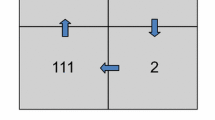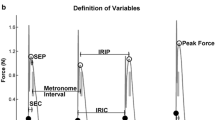Abstract
Synchronization of movement to a metronome is a well-studied task for both discretely and smoothly produced rhythmic movement. In particular, behavioral responses to unexpected changes in a regular metronome can reveal both the strength and the completeness of error correction mechanisms and temporal control. Clock-like control is exhibited by discretely produced movement and movement with discrete perceptual information, whereas smoothly produced movement does not rely on internal clock mechanisms. Documented differences in error correction between discretely and smoothly produced movements have been attributed to this different underlying control. In this study, error correction mechanisms were examined by inducing changes in the pace of rhythmic movement. An overshoot response following the pace change for both tapping and circle drawing is documented, and suggests the presence of phase and period correction in both tasks. The presence of phase correction in circle drawing also suggests that clock and non-clock timing may co-exist within the same movement. Furthermore, a sub-group of participants emerged who appropriately changed pace, but were not able to correct the phasing of their movement while performing the circle drawing task, supporting that phase and period maintenance in timing are independently controlled processes.




Similar content being viewed by others
References
Baer, L. H., Thibodeau, J. L., Gralnick, T. M., Li, K. Z., & Penhune, V. B. (2013). The role of musical training in emergent and event-based timing. Frontiers in Human Neuroscience, 7, 191.
Collins, D. F., Refshauge, K. M., Todd, G., & Gandevia, S. C. (2005). Cutaneous receptors contribute to kinesthesia at the index finger, elbow, and knee. Journal of Neurophysiology, 94, 1699–1706.
Delignières, D., & Torre, K. (2011). Event-based and emergent timing: dichotomy or continuum? A reply to Repp and Steinman (2010). Journal of Motor Behavior, 43, 311–318.
Elliott, M. T., Welchman, A. E., & Wing, A. M. (2009). Being discrete helps keeps to the beat. Experimental Brain Research, 192, 731–737.
Hary, D., & Moore, G. P. (1985). Temporal tracking and synchronization strategies. Human Neurobiology, 4, 73–77.
Huys, R., Studenka, B. E., Rheaume, N. L., Zelaznik, H. N., & Jirsa, V. K. (2008). Distinct timing mechanisms produce discrete and continuous movements. PLoS Computational Biology, 4, e1000061.
Huys, R., Studenka, B. E., Zelaznik, H. N., & Jirsa, V. K. (2010). Distinct timing mechanisms are implicated in distinct circle drawing tasks. Neuroscience Letters, 472, 24–28.
Loehr, J. D., Large, E. W., & Palmer, C. (2011). Temporal coordination and adaptation to rate change in music performance. Journal of Experimental Psychology: Human Perception and Performance, 37, 1292–1309.
Lorås, H., Sigmundsson, H., Talcott, J. B., Öhberg, F. O., & Stensdotter, A. K. (2012). Timing continuous or discontinuous movements across effectors specified by different pacing modalities and intervals. Experimental Brain Research, 220, 335–347.
Mates, J. (1994a). A model of synchronisation of motor acts to a stimulus sequence. I. Timing and error corrections. Biological Cybernetics, 70, 463–473.
Mates, J. (1994b). A model of synchronisation of motor acts to a stimulus sequence. II. Stability analysis, error estimation and simulations. Biological Cybernetics, 70, 475–484.
Proske, U., Schaible, H. G., & Schmidt, R. F. (1988). Joint receptors and kinaesthesia. Experimental Brain Research, 72, 219–224.
Repp, B. H. (2000). Compensation for subliminal timing perturbations in perceptual- motor synchronization. Psychological Research-Psychologische Forschung, 63, 106–128.
Repp, B. H. (2001a). Phase correction, phase resetting, and phase shifts after subliminal timing perturbations in sensorimotor synchronization. Journal of Experimental Psychology: Human Perception and Performance, 27, 600–621.
Repp, B. H. (2001b). Processes underlying adaptation to tempo changes in sensorimotor synchronization. Human Movement Science, 20, 277–312.
Repp, B. H. (2005). Sensorimotor synchronization: a review of the tapping literature. Psychonomic Bulletin and Review, 12, 969–992.
Repp, B. H. (2008). Perfect phase correction in synchronization with slow auditory sequences. Journal of Motor Behavior, 40, 363–367.
Repp, B. H., & Keller, P. E. (2004). Adaptation to tempo changes in sensorimotor synchronization: effects of intention, attention, and awareness. Quarterly Journal of Experimental Psychology, 57, 499–521.
Repp, B. H., & Steinman, S. R. (2010). Simultaneous event-based and emergent timing: synchronization, continuation, and phase correction. Journal of Motor Behavior, 42, 111–126.
Robertson, S., Zelaznik, H., Lantero, D., Gadacz, K., Spencer, R., Doffin, J., et al. (1999). Correlations for timing consistency among tapping and drawing tasks: evidence against a single timing process for motor control. Journal of Experimental Psychology: Human Perception and Performance, 25, 1316–1330.
Schöner, G. (2002). Timing, clocks, and dynamical systems. Brain and Cognition, 48, 31–51.
Spencer, R. M. C., Zelaznik, H. N., Diedrichsen, J., & Ivry, R. B. (2003). Disrupted timing of discontinuous but not continuous movements by cerebellar lesions. Science, 300, 1437–1439.
Studenka, B. E., & Zelaznik, H. N. (2011a). Synchronization in repetitive smooth movement requires perceptible events. Acta Psychologica, 136, 432–441.
Studenka, B. E., & Zelaznik, H. N. (2011b). Emergently timed circle drawing does not exhibit auditory-motor synchronization. Journal of Motor Behavior, 43, 185–191.
Studenka, B. E., Zelaznik, H. N., & Balasubramaniam, R. (2012). The distinction between tapping and circle drawing with and without tactile feedback: an examination of the sources of timing variance. The Quarterly Journal of Experimental Psychology, 65, 1086–1100.
Teulings, H. L., Contreras-Vidal, J. L., Stelmach, G. E., & Adler, C. H. (1997). Parkinsonism reduces coordination of fingers, wrist, and arm in fine motor control. Experimental Neurology, 146, 159–170.
Thaut, M. H., Miller, R. A., & Schauer, L. M. (1998). Multiple synchronization strategies in rhythmic sensorimotor tasks: phase vs. period correction. Biological Cybernetics, 79, 241–250.
Torre, K., & Balasubramaniam, R. (2009). Two different processes for sensorimotor synchronization in continuous and discontinuous rhythmic movements. Experimental Brain Research, 199, 157–166.
Torre, K., Balasubramaniam, R., & Delignières, D. (2010). Oscillating in synchrony with a metronome: serial dependence, limit cycle dynamics, and modeling. Motor Control, 14, 323–343.
Torre, K., & Delignières, D. (2008). Distinct ways of timing movements in bimanual coordination tasks: contribution of serial correlation analysis and implications for modeling. Acta Psychologica, 129, 284–296.
Wing, A. M., & Kristofferson, A. B. (1973). Response delays and the timing of discrete motor responses. Perception and Psychophysics, 14, 5–12.
Zelaznik, H. N., & Rosenbaum, D. A. (2010). Timing processes are correlated when tasks share a salient event. Journal of Experimental Psychology: Human Perception and Performance, 36, 1565–1575.
Zelaznik, H., Spencer, R. M. C., & Ivry, R. B. (2002). Dissociation of explicit and implicit timing in repetitive tapping and drawing movements. Journal of Experimental Psychology: Human Perception and Performance, 28, 575–588.
Zelaznik, H. N., Spencer, R. M. C., Ivry, R. B., Baria, A., Bloom, M., Dolansky, L., et al. (2005). Timing variability in circle drawing and tapping: probing the relationship between event and emergent timing. Journal of Motor Behavior, 37, 395–404.
Author information
Authors and Affiliations
Corresponding author
Rights and permissions
About this article
Cite this article
Studenka, B.E. Response to period shifts in tapping and circle drawing: a window into event and emergent components of continuous movement. Psychological Research 79, 500–512 (2015). https://doi.org/10.1007/s00426-014-0578-0
Received:
Accepted:
Published:
Issue Date:
DOI: https://doi.org/10.1007/s00426-014-0578-0




